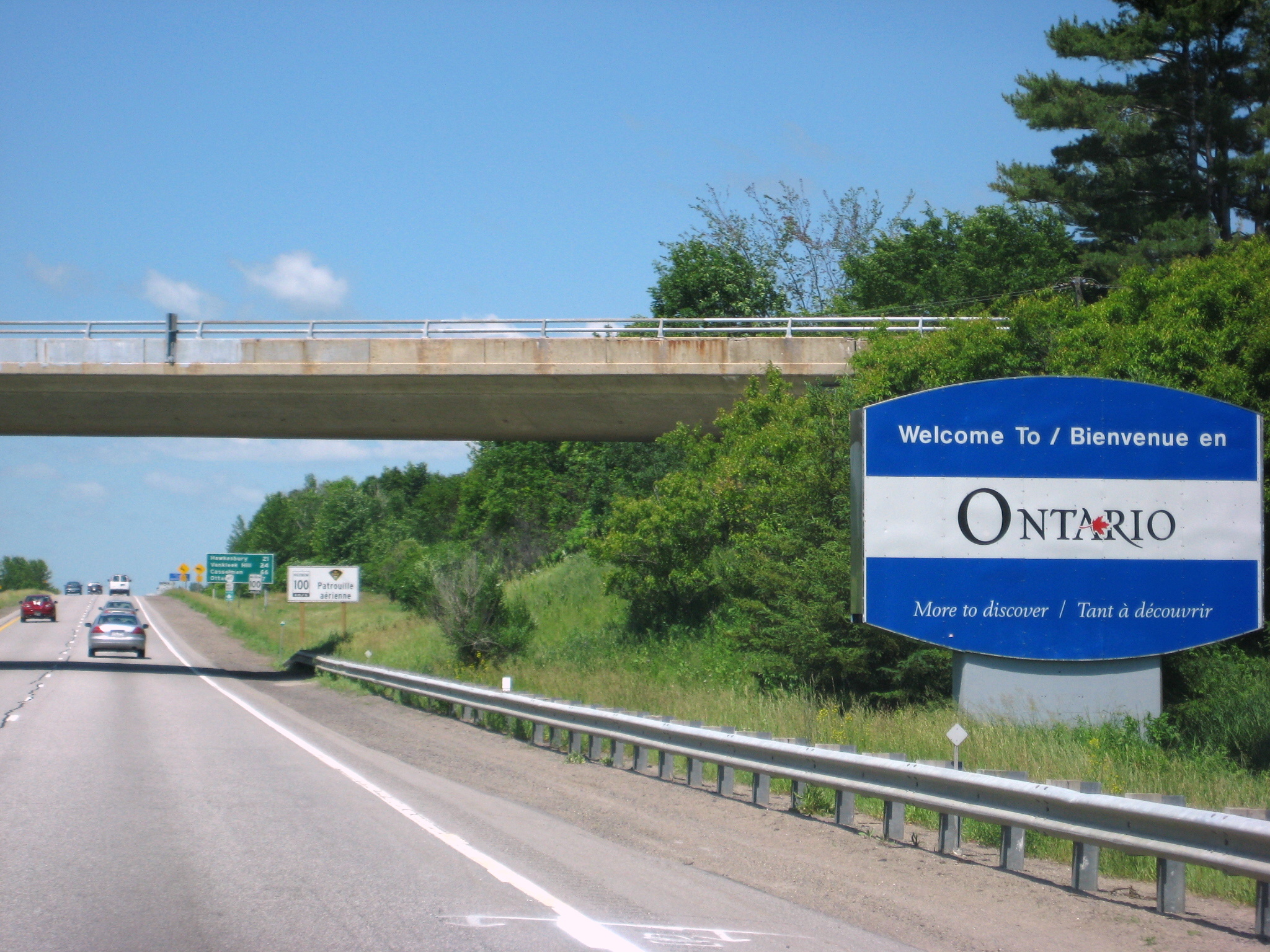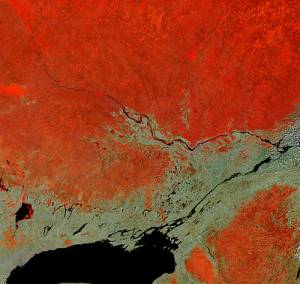|
Rockland, Ontario
Rockland is a bilingual community located about east of downtown Ottawa, Ontario, Canada, part of the city of Clarence-Rockland. Rockland has a population of 13,625 (2021), making up roughly half the population of the municipality. It is home to a large part of the francophone community in Eastern Ontario along with the towns situated to the east and the Ottawa suburb of Orleans to the west. It was a separate town until January 1, 1998, when it amalgamated with Clarence Township to form the City of Clarence-Rockland. History The Clarence region began growing in 1840 with the development of the road from L'Orignal to Bytown. Before then, farmers relentlessly cleared wooded space to be able to cultivate land, their only means of survival. In 1868, a young entrepreneur, William Cameron Edwards, decided to establish a sawmill at the McCaul point. The opening of a link to the Grand Trunk Railway followed in 1888 to allow wood and merchandise to be transported. Edwards, who held ... [...More Info...] [...Related Items...] OR: [Wikipedia] [Google] [Baidu] |
Provinces And Territories Of Canada
Canada has ten provinces and three territories that are sub-national administrative divisions under the jurisdiction of the Constitution of Canada, Canadian Constitution. In the 1867 Canadian Confederation, three provinces of British North America—New Brunswick, Nova Scotia, and the Province of Canada (which upon Confederation was divided into Ontario and Quebec)—united to form a federation, becoming a fully Independence, independent country over the next century. Over its history, Canada's international borders have changed several times as it has added territories and provinces, making it the List of countries and dependencies by area, world's second-largest country by area. The major difference between a Canadian province and a territory is that provinces receive their power and authority from the ''Constitution Act, 1867'' (formerly called the ''British North America Acts, British North America Act, 1867''), whereas territories are federal territories whose governments a ... [...More Info...] [...Related Items...] OR: [Wikipedia] [Google] [Baidu] |
Hull, Quebec
Hull is the central business district and oldest neighbourhood of the city of Gatineau, Quebec, Canada. It is located on the west bank of the Gatineau River and the north shore of the Ottawa River, directly opposite Ottawa. As part of Canada's National Capital Region, it contains offices for more than 20,000 civil servants. It was named after Kingston upon Hull in England. History Early history Hull is a former municipality in the Province of Quebec and the location of the oldest non-Indigenous settlement in the National Capital Region. Prior to European settlement, various Anishinaabe peoples including the Algonquins inhabited the area. It was founded on the north shore of the Ottawa River in 1800 by Philemon Wright at the portage around the Chaudière Falls just upstream (or west) from where the Gatineau and Rideau Rivers flow into the Ottawa. Wright brought his family, five other families and twenty-five labourers and a plan to establish an agriculturally based c ... [...More Info...] [...Related Items...] OR: [Wikipedia] [Google] [Baidu] |
École Secondaire Catholique L'Escale
L'École secondaire catholique l'Escale is a francophone Catholic high school located in Rockland, Ontario. It is managed by the Conseil scolaire de district catholique de l'Est ontarien. See also * Education in Ontario * List of secondary schools in Ontario The following is a list of secondary schools in Ontario. Secondary education policy in the Canadian province of Ontario is governed by the Ministry of Education. Secondary education in Ontario includes Grades 9 to 12. The following list includes ... References French-language high schools in Ontario {{Ontario-school-stub ... [...More Info...] [...Related Items...] OR: [Wikipedia] [Google] [Baidu] |
OC Transpo
OC Transpo is the primary Transit district, public transport agency for the city of Ottawa, Ontario, Canada, operating bus rapid transit, light rail, conventional transit bus, bus routes, and door-to-door paratransit in the nation's capital region. OC Transpo was established in 1948 as the Ottawa Transportation Commission, and currently operates three stadtbahn, urban rail lines, 11 bus rapid transit (BRT) lines, and 170 regular bus routes. OC Transpo serves List of O-Train stations, 25 light rail (O-Train) stations, and 43 BRT (Transitway (Ottawa), Transitway) stations. OC Transpo achieved a total ridership of 68 million in 2024. Ottawa was notable for its Transitway system, a network of grade separated busways linking outer suburbs to the downtown core which originally opened with five stations in 1983, and continued substantial expansion into the late 2000s. Much of the Transitway infrastructure has been, and is currently being, converted to light rail since the opening of th ... [...More Info...] [...Related Items...] OR: [Wikipedia] [Google] [Baidu] |
Bus Companies In Ontario
A bus (contracted from omnibus, with variants multibus, motorbus, autobus, etc.) is a motor vehicle that carries significantly more passengers than an average car or van, but fewer than the average rail transport. It is most commonly used in public transport, but is also in use for charter purposes, or through private ownership. Although the average bus carries between 30 and 100 passengers, some buses have a capacity of up to 300 passengers. The most common type is the single-deck rigid bus, with double-decker and articulated buses carrying larger loads, and midibuses and minibuses carrying smaller loads. Coaches are used for longer-distance services. Many types of buses, such as city transit buses and inter-city coaches, charge a fare. Other types, such as elementary or secondary school buses or shuttle buses within a post-secondary education campus, are free. In many jurisdictions, bus drivers require a special large vehicle licence above and beyond a regular driving l ... [...More Info...] [...Related Items...] OR: [Wikipedia] [Google] [Baidu] |
Ontario Highway 17
King's Highway 17, more commonly known as Highway 17, is a Provincial highways in Ontario, provincially maintained highway and the primary route of the Trans-Canada Highway through the Provinces and territories of Canada, Canadian province of Ontario. It begins at the Manitoba boundary, west of Kenora, and the main section ends where Ontario Highway 417, Highway 417 begins just west of Arnprior, Ontario, Arnprior. A small disconnected signed section of the highway still remains within the Ottawa Region between County Road 29 and Grants Side Road. This makes it Ontario's longest highway.See List of highways in Ontario for length comparisons. The highway once extended even farther to the Quebec boundary in East Hawkesbury, Ontario, East Hawkesbury with a peak length of about . However, a section of Highway 17 "disappeared" when the Ottawa section of it was upgraded to the freeway Highway 417 in 1971. Highway 17 was not re-routed through Ottawa, nor did it share numbering with Highwa ... [...More Info...] [...Related Items...] OR: [Wikipedia] [Google] [Baidu] |
Hawkesbury, Ontario
Hawkesbury is a town along the Ottawa River in the United Counties of Prescott and Russell in Eastern Ontario, Canada. Hawkesbury is the third most bilingual town in Ontario, with about 70% of its inhabitants being fluent in English and French. Franco-Ontarians make up 89% of the population. The Long-Sault Bridge links it to Grenville, Quebec, to the north. This bridge, crossing Chenail Island, is the only interprovincial bridge between Ontario and Quebec east of Ottawa. The town is located east from Ottawa, and is considered to be midway between Ottawa and Montreal. Etymology The name Hawkesbury derives from a combination of Hawks, a family name, and bury, a transformation of berry (castle). History Founded in 1798, Hawkesbury was named after the Right Honourable Charles Jenkinson, Baron Hawkesbury. Thomas Mears and David Pattee, two Americans, entered into a partnership in 1805, in order to harness the power of the lower Ottawa River and built the first sawmill on th ... [...More Info...] [...Related Items...] OR: [Wikipedia] [Google] [Baidu] |
Alfred And Plantagenet
Alfred and Plantagenet is a Franco-Ontarian township in eastern Ontario, Canada, in the United Counties of Prescott and Russell. Located approximately from downtown Ottawa at the confluence of the Ottawa River and the South Nation River. The township was formed on January 1, 1997, through the amalgamation of the townships of Alfred and North Plantagenet and the villages of Alfred and Plantagenet. Plantagenet is named after the House of Plantagenet, the royal house established by King Henry II. The township was settled in 1811-12, and its post office opened in 1838. Near the town of Alfred, the Ontario Ministry of Natural Resources has designated the Alfred Bog as "a provincially significant wetland and an Area of Natural and Scientific Interest." Species of interest include the palm warbler, northern pitcher-plant, pink lady's-slipper, cottongrass, bog elfin and bog copper butterflies, and ebony boghaunter dragonfly. It also hosts one of the most southerly herds ... [...More Info...] [...Related Items...] OR: [Wikipedia] [Google] [Baidu] |
Ontario Highway 417
King's Highway 417, commonly referred to as Highway 417 and as the Queensway through Ottawa, is a 400-series highway in the Provinces and territories of Canada, Canadian province of Ontario. It connects Ottawa with Montreal via Quebec Autoroute 40, A-40, and is the backbone of the highway system in the National Capital Region (Canada), National Capital Region. Within Ottawa, it forms part of the Queensway west from Ontario Highway 7, Highway 7 to Ottawa Road 174. Highway 417 extends from the Quebec border, near Hawkesbury, Ontario, Hawkesbury, to Arnprior, Ontario, Arnprior, where it continues westward as Ontario Highway 17, Highway 17. Aside from the urban section through Ottawa, Highway 417 passes through farmland that dominates much of the fertile Ottawa Valley. Within Ottawa, the Queensway was built as part of a Greber Plan, grand plan for the city between 1957 and 1966, and later reconstructed to its present form throughout the 1980s. The eastern sect ... [...More Info...] [...Related Items...] OR: [Wikipedia] [Google] [Baidu] |
Ottawa Regional Road 174
Ottawa Road 174, formerly Ottawa-Carleton Regional Road 174 and commonly referred to as Highway 174, is a municipal expressway and numbered road in the City of Ottawa which serves the eastern suburbs of Orléans and Cumberland. The four-lane freeway segment between Highway 417/Aviation Parkway junction to Trim Road (Ottawa Road57) is also known as the Queensway, in addition the ''Queensway'' name continues to be applied to Highway417 west of that intersection. Although the road continues through the towns of Rockland and Hawkesbury to the Quebec border, the portion east of the Ottawa city boundary is known as Prescott and Russell County Road17. Originally the alignment of Highway 17, which was the route of the Trans-Canada Highway between Ottawa and the Quebec border, Regional Road174 (as it was then designated) was created on April1, 1997 when the provincial government transferred responsibility for portions of the road to the township of Gloucester and the township of ... [...More Info...] [...Related Items...] OR: [Wikipedia] [Google] [Baidu] |
Ottawa River
The Ottawa River (, ) is a river in the Canadian provinces of Ontario and Quebec. It is named after the Algonquin word "to trade", as it was the major trade route of Eastern Canada at the time. For most of its length, it defines the border between these two provinces. It is a major tributary of the St. Lawrence River and the longest river in Quebec. Geography The river rises at Lac des Outaouais, north of the Laurentian Mountains of central Quebec, and flows west to Lake Timiskaming. From there its route has been used to define the interprovincial border with Ontario. From Lake Timiskaming, the river flows southeast to Ottawa and Gatineau, where it tumbles over Chaudière Falls and further takes in the Rideau River, Rideau and Gatineau River, Gatineau rivers. The Ottawa River drains into the Lake of Two Mountains and the St. Lawrence River at Montreal. The river is long; it drains an area of , 65 per cent in Quebec and the rest in Ontario, with a mean discharge of . ... [...More Info...] [...Related Items...] OR: [Wikipedia] [Google] [Baidu] |
Hockey Canada
Hockey Canada (which merged with the Canadian Amateur Hockey Association in 1994) is the national governing body of ice hockey and ice sledge hockey in Canada. It is a member of the International Ice Hockey Federation and controls the majority of organized ice hockey in Canada. There are some notable exceptions, such as the Canadian Hockey League, U Sports (formerly known as Canadian Interuniversity Sport), and Canada's professional hockey clubs; the former two are partnered with Hockey Canada but are not member organizations. Hockey Canada is based in Calgary, with a secondary office in Ottawa and regional centres in Toronto, Winnipeg and Montreal. History The Canadian Amateur Hockey Association was founded on December 4, 1914, when 21 delegates from across Canada met at the Chateau Laurier in Ottawa. The organization was made to oversee the amateur level of the sport at the national level. The Allan Cup, originally donated in 1908 by Sir H. Montagu Allan, was selected as ... [...More Info...] [...Related Items...] OR: [Wikipedia] [Google] [Baidu] |




